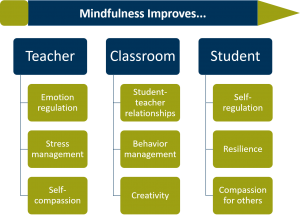Mindfulness in Classrooms
Mindfulness in Classrooms
Previously, we discussed how mindfulness benefits teachers by reducing burnout, improving emotional intelligence, and promoting self-compassion. But mindfulness can help more than just teacher well-being—it can benefit the classroom dynamic as a whole.
The “Burnout Cascade”
Emotions are contagious, so when you’re physically and emotionally exhausted, your stress spills over into the classroom. Minor annoyances easily get under your skin, thus making you more likely to overreact to disruptive student behaviour. As a result, this weakens the classroom’s learning environment and may promote further misbehavior[1],[2]. Classrooms with stressed teachers consquently have more stressed students[3].
The benefits of teacher mindfulness transfer from their personal well-being to the classroom. Researchers found that a teacher’s well-being affects their classroom’s atmosphere as a learning environment. For example, some benefits include:
- Better student-teacher relationships. Mindful teachers are more emotionally supportive of their students. This is especially apparent with difficult or challenging students[4].
- Better classroom management. Research links mindfulness in teachers to proactive management of student behavior. Moreover, it is associated with improved student engagement using different learning formats[5].
- Better creativity. Mindfulness in classrooms is associated with greater creativity[6] in teachers and students, thus leading to more innovative problem-solving[7].
Mindfulness in Classrooms Helps Your Students
Several benefits that mindfulness gives teachers also apply to students. Mindfulness in classrooms can develop children’s social, cognitive, and emotional resources, including:
- Self-regulation. Children often have trouble calming down when upset, overstimulated, or stressed, because they haven’t developed the cognitive resources needed to regulate their emotions. In children, mindfulness has been linked to better self-regulation and attention[8].
- Resilience. Just as teachers experience considerable stress, so do their students. For example, student stress can come from academic demands, conflicts with peers, and family dynamics[9]. In children of divorced parents, those who received mindfulness training were less depressed, less anxious, and more emotionally resilient[10].
- Compassionate behaviour. Children with mindfulness training show greater self-compassion and empathy[11]. Subsequently, they are kinder, more considerate, and more likely to share with others[12].
Getting Started With Mindfulness
Mindfulness practice might seem challenging to fit into a busy schedule—but it doesn’t have to involve sitting quietly for half an hour. Getting started can be as simple as taking a walk during your break and being attentive to your surroundings, or beginning your workday with a mindful pause.
How SIGMA Can Help
SIGMA offers a range of services to help you introduce mindfulness into your life and sustain your practice over time. Check out our mindfulness page for our webinar, a sample of our mindfulness practices, and our workshop offerings for more information. If you’d like to learn more about how mindfulness can benefit you, contact us today.
References
[1] Clunies‐Ross, P., Little, E., & Kienhuis, M. (2008). Self‐reported and actual use of proactive and reactive classroom management strategies and their relationship with teacher stress and student behaviour. Educational Psychology, 28, 693-710. doi:10.1080/01443410802206700
[2] Jennings, P. A., & Greenberg, M. T. (2009). The prosocial classroom: Teacher social and emotional competence in relation to student and classroom outcomes. Review of Educational Research, 79, 491-525. doi:10.3102/0034654308325693
[3] Oberle, E., & Schonert-Reichl, K. A. (2016). Stress contagion in the classroom? The link between classroom teacher burnout and morning cortisol in elementary school students. Social Science & Medicine, 159, 30-37. doi:10.1016/j.socscimed.2016.04.031
[4] Jennings, P. A. (2015). Early childhood teachers’ well-being, mindfulness, and self-compassion in relation to classroom quality and attitudes towards challenging students. Mindfulness, 6, 732-743. doi:10.1007/s12671-014-0312-4
[5] Braun, S. S., Roeser, R. W., Mashburn, A. J., & Skinner, E. (2019). Middle school teachers’ mindfulness, occupational health and well-being, and the quality of teacher-student interactions. Mindfulness, 10, 245-255. doi:10.1007/s12671-018-0968-2
[6] Gouda, S., Luong, M. T., Schmidt, S., & Bauer, J. (2016). Students and teachers benefit from mindfulness-based stress reduction in a school-embedded pilot study. Frontiers in Psychology, 7, 590-590. doi:10.3389/fpsyg.2016.00590
[7] Ostafin, B. D., & Kassman, K. T. (2012). Stepping out of history: Mindfulness improves insight problem solving. Consciousness and Cognition, 21, 1031-1036. doi:10.1016/j.concog.2012.02.014
[8] Semple, R., Lee, J., Rosa, D., & Miller, L. (2010). A randomized trial of mindfulness-based cognitive therapy for children: Promoting mindful attention to enhance social-emotional resiliency in children. Journal of Child and Family Studies, 19, 218-229. doi:10.1007/s10826-009-9301-y
[9] Meiklejohn, J., Phillips, C., Freedman, M. L., Griffin, M. L., Biegel, G., Roach, A., …, & Saltzman, A. (2012). Integrating mindfulness training into K-12 education: Fostering the resilience of teachers and students. Mindfulness, 3, 291-307. doi:10.1007/s12671-012-0094-5
[10] Esmaeilian, N., Dehghani, M., Dehghani, Z., & Lee, J. (2018). Mindfulness-based cognitive therapy enhances emotional resiliency in children with divorced parents. Mindfulness, 9, 1052-1062. doi:10.1007/s12671-017-0840-9
[11] Cheang, R., Gillions, A., & Sparkes, E. (2019). Do mindfulness-based interventions increase empathy and compassion in children and adolescents: A systematic review. Journal of Child and Family Studies, 28, 1765-1779. doi:10.1007/s10826-019-01413-9
[12] Viglas, M., & Perlman, M. (2018). Effects of a mindfulness-based program on young children’s self-regulation, prosocial behavior and hyperactivity. Journal of Child and Family Studies, 27, 1150-1161. doi:10.1007/s10826-017-0971-6
